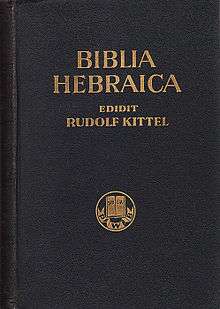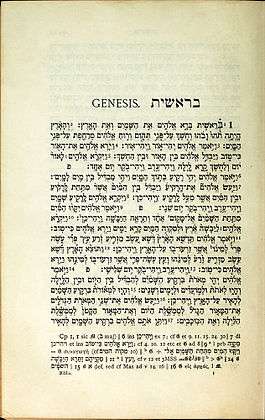Biblia Hebraica (Kittel)
Biblia Hebraica refers primarily to the three editions of the Hebrew Bible edited by Rudolf Kittel. When referenced, Kittel's Biblia Hebraica is usually abbreviated BH, or BHK (K for Kittel). When specific editions are referred to, BH1, BH2 and BH3 are used. Biblia Hebraica is a Latin phrase meaning Hebrew Bible, traditionally used as a title for printed editions of the Tanakh. Less commonly, Biblia Hebraica may also refer to subsequent editions in the Biblia Hebraica series which build on the work of Kittel's editions.
 | |
BHK Biblia Hebraica Kittel (1. - 3.) BHS Biblia Hebraica Stuttgartensia (4.) BHQ Biblia Hebraica Quinta (5.) | |
| Edited by | Rudolf Kittel, Paul Kahle |
|---|---|
| Language | Biblical Hebrew, Biblical Aramaic |
| Published | BH1: 1906, BH2: 1913, BH3: 1937 |
| Followed by | Biblia Hebraica Stuttgartensia |
| Website | https://www.academic-bible.com/en/home/scholarly-editions/hebrew-bible/bhk/ |

First and second editions
The Old Testament scholar Rudolf Kittel from Leipzig started to develop a critical edition of the Hebrew Bible in 1901, which would later become the first of its kind. His first edition Biblia Hebraica edidit Rudolf Kittel was published as a two-volume work in 1906 under the publisher J. C. Hinrichs in Leipzig.[1]
As a textual basis for his edition he reproduced the Hebrew text found in the Mikraot Gedolot (also cited as Bombergiana or ""), the rabbinic Bible from Jacob ben Hayyim ibn Adonijah printed by Daniel Bomberg in Venice in 1524/1525 which had been generally accepted as the representative Hebrew text for centuries up to that point. Kittel printed the text with the Hebrew consonants, vowels (Niqqud) and Cantillation marks as found in the Bomberg Bible, although his editions did not include Masoretic notes, whereas the Bomberg edition did.
In the bottom part of the page he added his critical apparatus where he listed textual variants from other ancient manuscripts (especially the Septuagint; but also from the Samaritan Pentateuch and early Bible translations such as the Latin Vulgate and Syriac Peshitta) and conjectural emendations.
The second edition of Kittel's Biblia Hebraica appeared in 1913; the differences between it and the first one are slight, apart from a list of errors in the second. It was reprinted several times.
Third edition
In 1921 the Bible Society Württemberg (Württembergische Bibelanstalt) bought the rights for Kittel's Biblia Hebraica from J. C. Hinrichs and alongside further reprints of the existing edition, approaches for a third edition were planned from 1925 onwards. The third edition had a slightly different Hebrew text and completely revised footnotes. For the first time, a Bible reproduced the text of the Leningrad Codex from the year 1008, since it was (and still is) the oldest existing manuscript of the entire Hebrew Bible. The idea to use that Codex is credited to Paul Kahle, who discovered its importance. The BH3 reproduces the Masoretic Text in the Codex exactly, without any editing.
The critical apparatus was separated into two different categories, "mere variants and less important notifications" (in German: bloße Varianten und minder wichtige Mitteilungen) and "the actual textual changes and otherwise more considerable things" (in German: die wirklichen Textänderungen und das sonst Bedeutsamere) to inform the reader of the emphasis in the list of variants.
In its approach to reproduce the Leningrad Codex it also featured for the first time the Masoretic notes found on the left and right margins of the Codex, the so-called Masora Parva, although without any explanations to it. These marginal notes were of great importance to the editors of the subsequent editions (the BHS began to redact the Masora Parva and also to implement references to the notes on the top and bottom of the page, the so-called Masora Magna).
BH3 appeared in installments, from 1929 to 1937, with the first one-volume edition in 1937; it was reprinted many times, with later editions recording variants in the Book of Isaiah and Habakkuk from the Dead Sea Scrolls.
Some of the references in the textual apparatus reference manuscripts that no longer exist due to the bombing of Leipzig during World War II.[2]
Subsequent editions
The third edition was superseded by the Biblia Hebraica Stuttgartensia. The current project in this tradition is the Biblia Hebraica Quinta.
See also
References
- "The Biblia Hebraica Kittel Origin Story". Deutsche Bibelgesellschaft Stuttgart.
- "BHK". academic-bible.com.
External links
- Biblia Hebraica (1st ed.) on archive.org Vol I Vol II